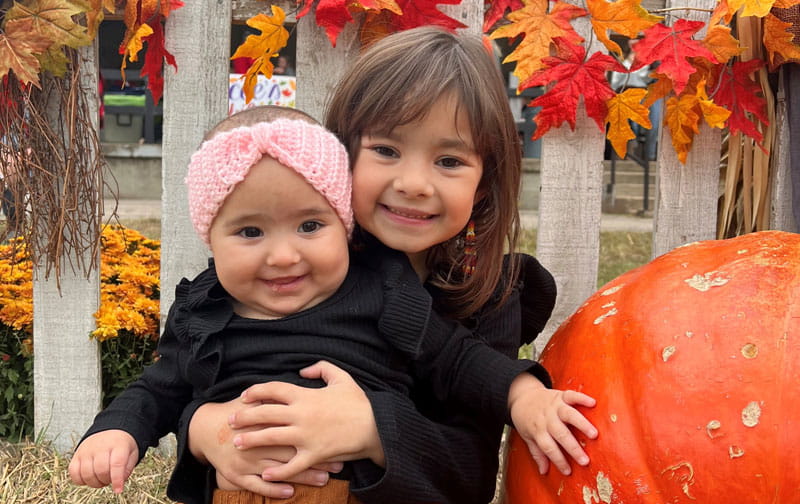Alora, Sloan and Scarlett's CHD Story

When Sloan Eleana was born in a California hospital five years ago, she was whisked into the neonatal intensive care unit because her blood sugar was low.
By dawn the next day, doctors had detected a heart murmur. Within three hours, baby Sloan was on her way in an ambulance to a children’s hospital in San Diego. There, she was diagnosed with tetralogy of Fallot, a congenital heart defect that is caused by a combination of four heart defects.
“When you hear ‘heart,’ you think of the worst possible things: What happened? What are they going to do?” said Alora Allen, Sloan’s mother who had a normal pregnancy aside from gestational diabetes. “I’d had a C-section, so I had to stay at the hospital while they transferred her. It was horrible, actually.”
She and her husband, Taylor, knew nothing about congenital heart defects. No wonder that moment by moment, update by update, they were shocked, anxious, even terrified.
Initially, she and Taylor couldn‘t even hold their baby. Only after several days could they feed her.
Meanwhile, doctors were trying to stabilize Sloan so she could go home for a few months before surgery. But she needed it within weeks. Doctors closed the hole in her heart, opened her arteries, shaved down the right side of her heart (which was thicker than the left) and replaced her pulmonary valve.
Eight days later, Mom and Dad brought Sloan home.
One day, the energetic pre-kindergarten student will need the valve replaced again and will always be under the care of a cardiologist.
For now, she goes to the cardiologist yearly and her restrictions are few. Because she’s at risk for pneumonia and respiratory syncytial virus (RSV), her parents take extra precautions and will keep her home if a classmate is sick. If they travel where there are high altitudes they always confirm with Sloan’s cardiologist to make sure it is safe.
Alora is vigilant without hovering — for Sloan as well as for her year-old daughter, Scarlett, who was born with an atrial septal defect, or ASD, which is a “hole” in the wall that separates the top two chambers of the heart. Scarlett also had pulmonary valve stenosis, a narrowing of the valve between the lower right heart chamber and the lung arteries.
Fortunately, Scarlett’s CHDs are correcting themselves and won’t need surgery. If she did, Alora and her husband would at least have an idea of what to expect. Early into Sloan’s diagnosis, unknowns were pervasive and fear enveloped them.
So Alora reached out to a moms group on the hospital’s Facebook page. A mom reached out whose daughter had the same diagnosis. The two met and talked, and Alora felt comforted and, eventually, invigorated to help other moms going through similar experiences.
“Seeing Sloan attached to all the different tubes and wires, I thought we’d be on oxygen at home and have to be extremely careful,” Alora said. “We’re a very active family. We wondered, ‘Will she even play soccer?’ There are a lot of unknowns; it’s very hard to not go down that rabbit hole and get lost.”
Sloan tried soccer and t-ball. But she’s a “girly girl,” her mom said, and she wants to take dance lessons and do gymnastics instead.
Becoming informed about CHD buoyed Alora and her determination to help others.
“You feel so alone,” she said. “Nobody in my family or any of our friends knew what a congenital heart defect was. It was scary. I did research and found out it’s the No. 1 birth defect. Every 15 minutes(link opens in new window), a baby is born with a congenital heart defect. You read that and think, ‘How do people not know about this?’”
Determined to get the word out, she began volunteering for the Children’s Heart Foundation(link opens in new window). On Sloan’s first birthday, Alora made 50 goodie bags filled with crocheted beanies, copies of ‘Its My Heart’, a copy of their story and distributed them at the children’s hospital where Sloan was impatient and had her open heart surgery.
When the family moved to Tulsa, Oklahoma, she worked hard to bring the Congenital Heart Walk to the city.
“We’re growing every year and I love it,” she said. “Moms here are extremely happy to be part of it. I want parents who are going through this to know that you are not alone. There is a support system here for you and there is a light at the end of your tunnel.”
As for Sloan and Scarlett, they’re growing, thriving — and loving being sisters.
“I know Sloan will forever have to be with a cardiologist and maybe more surgeries, but I want her life to be normal, “Alora said.
Sloan has begun asking questions about her heart, the scar on her chest and why she sometimes gets tired while playing. Alora takes a deep breath and answers them honestly, encouraging her daughter’s independence and spirit.
“It’s hard, especially whenever I see Sloan sick, because it takes me back,” Alora said. “I have to check myself. If she seems tired or slows down, I ask once if she’s OK, and if she says she’s fine … she’s fine.”





